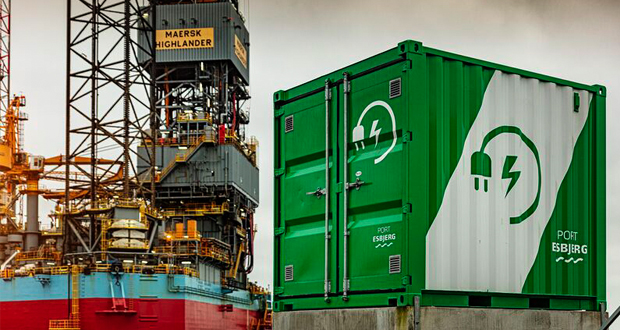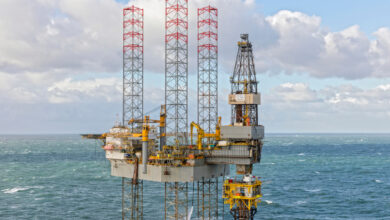Maersk Drilling connects jackup to shore power at Port Esbjerg in Denmark

Maersk Drilling has connected its first rig to the green shore-to-ship power unit at Port Esbjerg in Denmark, the company and the port announced on social media. The shore power unit, the first of its kind in Denmark, reduces carbon emissions substantially and is entirely in line with both Port Esbjerg’s and Maersk Drilling’s focus on sustainability and green transition.
The Maersk Highlander jackup is currently connected to shore-to-ship power at Doggerkaj. The power plant has a capacity of 1,300 Amp/1.5 MW and can supply power to up to three rigs, which requires up to 10,000 kWh every 24 hours. The potential reduction in carbon emissions is substantial but the actual figures will naturally depend on how long the rigs are docked.
“We’re delighted to have the opportunity to use green shore-to-ship power while our rigs are docked at Esbjerg to be readied for new assignments. Maersk Drilling is a first mover in the industry with the ambition to halve its carbon emissions intensity by 2030, and the use of shore-to-ship power contributes to this objective,” said Claus Bachmann, Head of North Sea Division at Maersk Drilling.
Many of the other ships at the port have had the option to connect to shore-to-ship power for several years; the news is that the port of Esbjerg now has the capacity to supply shore-to-ship power to drilling rigs, which require huge quantities of power.
“More and more customers ask for shore-to-ship power, so for us, it’s not just a matter of participating actively in the green transition, on which we’re already heavily focused. It’s also a commercial necessity, which is why we’re in the process of installing more shore-to-ship power plants at the port, so even more of our customers have the opportunity to use green power,” said Port Esbjerg CEO Dennis Jul Pedersen.
The potential reduction of carbon emissions from using shore-to-ship power rather than diesel generators is up to 500 tonnes of CO2 per month per rig, and emissions of SOx and NOx are also reduced.




